Last May, Google made big waves at their annual Google Marketing Live event and announced tons of planned new features and tools to help advertisers find customers online. Among these announcements was a new ad type called Discovery ads, designed to help advertisers get their products discovered by potential audiences across Google’s popular properties.
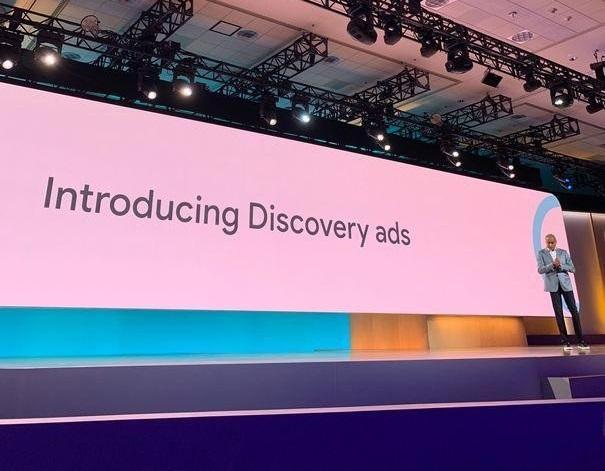
These new discovery ads allow advertisers to show their products to targeted audiences for the first time ever on Google’s Discover feed as well as prominently at the top of YouTube and Gmail. These prominent ad placements reach audiences in the moments even before they search. According to Google, nearly 85% of people will take action within 24 hours of discovering a new product so these ads can significantly impact your customer’s journey to purchasing from you.
It might sound like a branding play at first, but Google’s automation can deliver high direct ROI as well. The campaign not only drives conversions, but it does so inexpensively—the average CPA on Discovery campaigns today is only $12.19!
Last week, Google announced these Discovery ads are now available to all advertisers globally! Here’s everything you need to know to make the most of this ad type.
Note: Google announced Discovery Ads will be upgraded to Demand Gen campaigns in early 2024. We cover what you need to know here.
What are Google Discovery ads?
Google’s newest Discovery ads are an easy way to get your products shown to your highest value customers. Discovery campaigns streamlines much of the ad testing, targeting, and campaign optimization with robust machine learning to target your ads across YouTube, Gmail, and the Discover feed all in one campaign type.
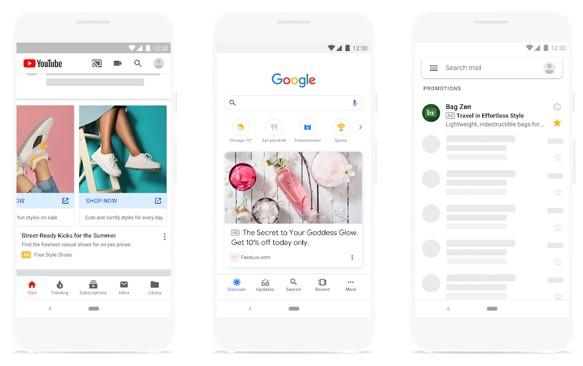
Advertisers still control their daily budget, target audiences and guide Google in crafting ad creative and campaign conversion goals to optimize towards across their networks.
Google Discovery ad formats
Google’s Discovery campaigns offer two unique ad formats, standard (single image) Discovery Ads and Discovery Carousel Ads. Much like Responsive Search ads and Responsive Display ads, advertisers provide Google with several different assets for Google to dynamically test different ad variants to show different customers more customized messaging.
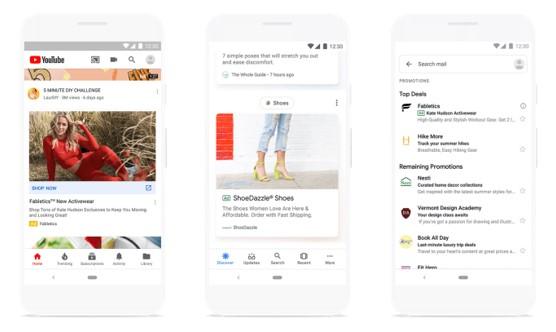
Standard Discovery ads
A Discovery ad needs to have several unique assets:
- Final URL: After clicking on your ad, this is where the ad directs. To ensure a higher ad quality and conversion rate, set your final URL to a page where someone can learn more about the specific product you are advertising, and they can potentially buy it. Avoid sending people to your homepage.
- Images: Discovery ads are meant to inspire and stop your audience mid-scroll on these high traffic pages, so tap into your creative resources. Don’t play it safe – this isn’t the search engine results page and you’re not just competing against text on these pages. Stand out with bold colors and visual contrast, like you might in a Facebook ad. Google has plenty of creative suggestions to get your ideas flowing.
You can upload up to 15 different images for Google to test in a Discovery ad. Test out different images and sizes (Square 1:1 and Landscape 1.91:1) to get the most reach.
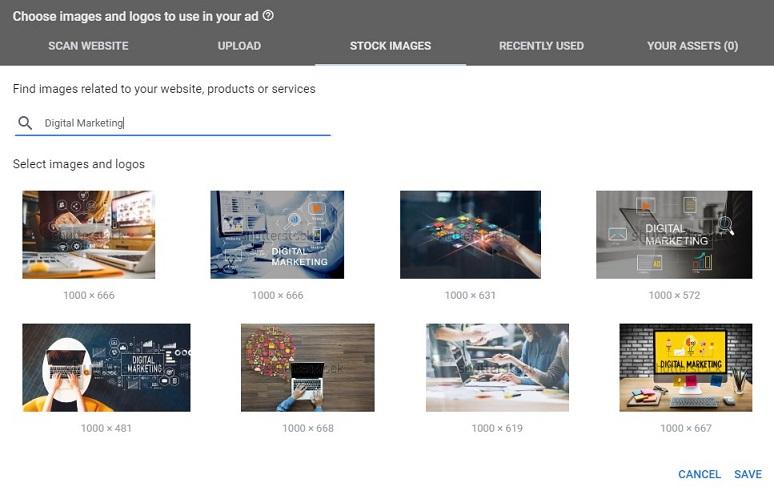
You can choose to upload your own images, search for stock images on Shutterstock, have Google scan images from your website, or even use images from your social media feeds on Facebook, Twitter, Instagram, or LinkedIn.
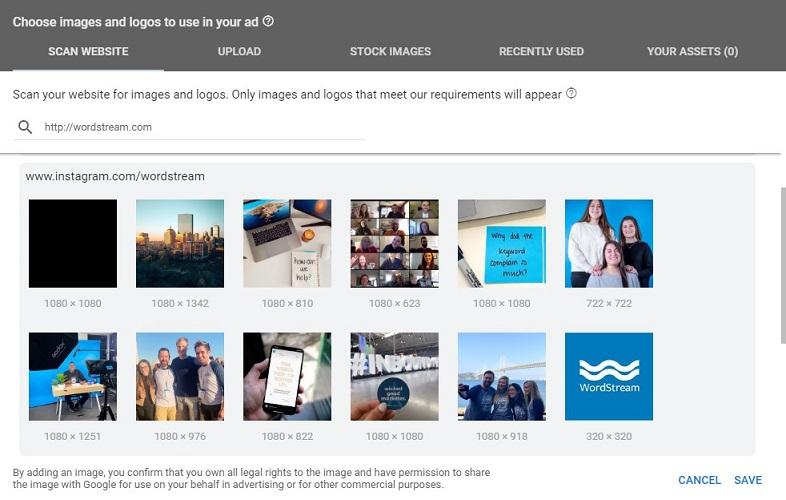
- Headlines: Your headline will be featured as the first line of your ad in bold. You can provide up to five headlines, each with 40 characters.
- Descriptions: Your descriptions will appear below your headlines and is your opportunity to provide more compelling messaging to your ad copy. You can provide up to five descriptions, each with 90 characters.
- Business Name: Your business name will appear alongside your ad. Keep your business name consistent to how people would call or search for you.
- Call to Action (optional): You can choose from several popular call-to-action buttons (such as “Shop Now” or “Get Quote”) to include alongside your ad. Alternatively, you can allow Google to test and optimize this call-to-action for you.
Discovery Carousel ads
The carousel ad format is very similar to the standard Discovery ad format but allows for users to scroll through all the images you provide in a carousel format. Advertisers can upload between two and 10 images to be used as cards in the carousel, and Google will display them in the order you upload them.
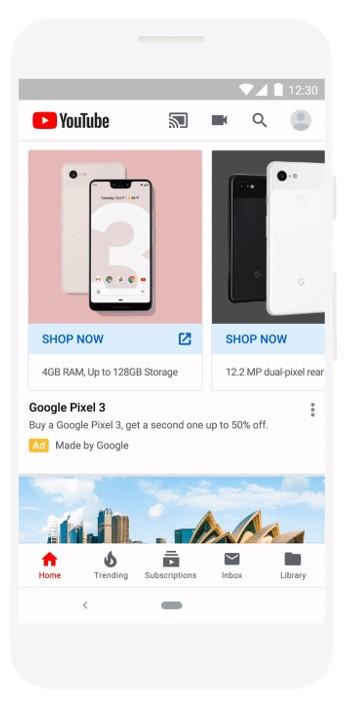
Keep in mind that Google only allows square images or landscapes with an aspect ratio of 1.91:1 to be used for cards and all the images within a Discovery Carousel ad must either be square OR landscape. You can’t mix square and landscape ads in the same Discovery Carousel ad or the entire ad may be disapproved.
Google Discovery ad targeting
Unlike search campaigns, Google Discovery ads aren’t targeted by keywords. Instead, advertisers can choose which audiences they want to reach with their ads. Advertiser can target their ads to specific audiences including:
- Remarketing: Remarketing allows you to target your ads to past customers or website visitors. You can create different remarketing audiences based on their past interactions (visits to a key page, shopping cart abandoners, recently purchased from you) to reengage prospects who are already familiar with your brand.
- Detailed Demographics: Demographic targeting on Google allows you to target your ads to users based on their age, gender, parental status, relationship, education, and homeownership status.
- In-Market Audiences: In-market audiences reach users whom have recently begun to search, browse, and are actively considering making a purchase. Google has hundreds of different in market audiences for people ready to buy everything from a new car, computer, or payroll system.
- Life Events: Life events lets you target people who just are about to have a major milestone, such as starting a business, changing jobs, graduating, getting married, or buying a home.
- Affinity & Custom Intent: Affinity audiences and custom intent audiences reach users based on the topics and interests that people have searched for and browsed in the past.
Alternatively, if you do not choose any specific audiences, Google will target your ads to a wide audience and do leverage its own signals to optimize who sees your ads.
If you want to target more than one audience, you can create several ad groups or discovery campaigns to do so.
Google Discovery ad bidding and budgets
Google’s Discovery campaigns are built machine learning and rely upon Google’s Smart Bidding strategies. Currently, Discovery campaigns only support two bidding strategies:
- Target CPA: Google will attempt to drive conversions at a specific cost per conversion. It’s recommended you use this strategy if you’ve got budget that’s at least 10 times your target CPA.
- Maximize Conversions: Google will attempt to drive as many conversions at the lowest CPA possible. This is best for advertisers who may have smaller budgets or wouldn’t expect to see 10 conversions a day.
The average CPA on Google Discovery campaigns is only about $12, so most advertisers can get a lot out of small budgets. Still, industries that normally see higher CPAs on search and display should expect CPAs more in line with their account norm.
When first launching or making changes to a campaign, Google advises to wait two or three weeks between testing new bids or changing ads so that it can learn how users react and adjust to shifts to performance in real time.
How do I create Discovery campaigns in Google Ads?
Creating a Google Discovery Campaign is straight forward if you are familiar with the Google Ads interface.
1. Create a new campaign by hitting the “+” blue icon on the campaigns page.
2. When selecting your campaign’s goal, choose “Sales,” “Leads,” or “Website Traffic.” Alternatively, you can create a campaign without a goal’s guidance.
3. Select the “Discovery” campaign type.
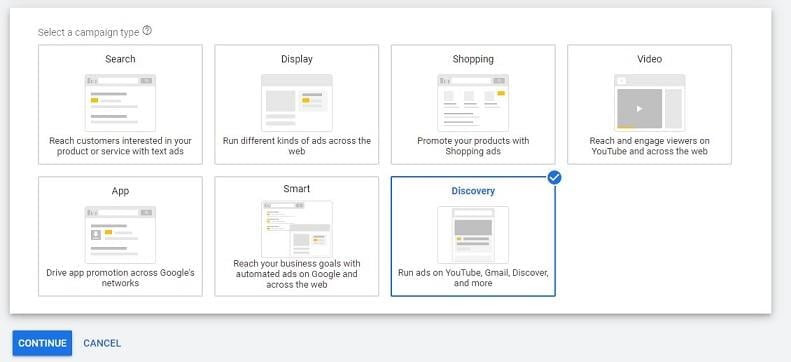
4. Name your new campaign. Select which languages and where you would like your ads to run.
5. Set your daily budget and which bidding strategy you’d like Google to rely on to optimize your Discovery campaign (Currently only Maximize Conversions or Target CPA options are allowed).
6. Review “additional settings” if you want:
- Your campaign to have a set start and end date
- Your campaign to only run certain hours of the day or days of the week
- You only want your campaigns to optimize for certain conversion actions in your account.
7. Create your first ad group and audience targets. Mind that you can create more than one ad group later if you want to target more audiences.
8. Upload your Discovery ads.
You will then be prompted to review your new Discovery campaign before launching it. Smash that continue button and your campaign goes live!
Google’s Discovery campaigns harness sophisticated audience signals and machine learning to find you more customers in an easy to manage campaign type. Our clients got a lot out of Google’s Discovery campaigns while they were in beta, so we’re excited to see them globally available to all advertisers today.
Want to know the difference between Google Discovery Ads vs. Display Ads? We’ve got you covered!







